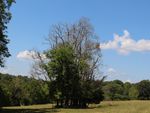LAUREL WILT - University of Tennessee Extension
←
→
Page content transcription
If your browser does not render page correctly, please read the page content below
W 1007 LAUREL WILT Prepared by Walker Fowler, Alan Windham and Denita Hadziabdic Department of Entomology and Plant Pathology What is Laurel Wilt? Laurel wilt is a disease afecting trees and shrubs in the laurel family (Lauraceae). The disease is caused by the fungal pathogen, Rafaelea lauricola, and transmitted by the wood-boring redbay ambrosia beetle, Xyleborus glabratus. Both the pathogen and insect vector were introduced to the United States on imported wood packing materials from Asia. Redbay ambrosia beetles bore inside the wood, lay their eggs, and create tunnels (or galleries) spreading the fungus throughout the tree. The beetles then use the fungus as a food source. The fungus eventually clogs the water-conducting cells of an afected tree, causing it to wilt and eventually starve to death. As of 2021, the disease has been detected in several counties in Tennessee. Native trees afected include sassafras (Sassafras albidum) and northern spicebush (Lindera benzoin). Ornamental and landscape trees in the Lauraceae family may also be impacted. Identifcation In the early stages of laurel wilt, trees may exhibit discolored, drooping leaves. In deciduous trees Figure 1. Laurel wilt external symptoms with discolored, native to Tennessee, leaves will soon fall from the wilted leaves. Laurel Wilt 1
tree, leaving bare branches. In contrast, evergreen
members of the Lauraceae family may hold reddish
or brown leaves for many months. Sassafras trees
that survive the initial infection may fush sparse,
stunted leaves the following spring. Removal of
bark from wilted trees will reveal a brown to black
discoloration (Figure 2) in the sapwood which runs
in streaks parallel to the wood grain. The extent of
this discoloration will vary based on how long the
tree has been infected.
Initial attacks from redbay ambrosia beetles are very
difcult to detect. The beetles themselves are very
small (about 2mm long), and the holes bored into
tree stems and trunks are of similar size. However,
after the tree is inoculated and starts to wilt, the
beetles will begin to attack in greater numbers and
small tubes of compacted sawdust may protrude
from the boreholes. In Tennessee, a limited number
of redbay ambrosia beetles have been reported.
However, survey results in Kentucky have indicated
a large number of beetles collected across multiple,
diferent sites.
Figure 3 and 4. Discoloration of the upper canopy is rapid
(top), resulting in complete defoliation and eventual tree
death (bottom).
Current Disease Range
Figure 2. Internal vascular discoloration on sassafras.
and Distribution
Confrmation of laurel wilt is typically done
Management Strategies and What by laboratory isolation of the R. lauricola fungus
from fresh wood samples, collected from hosts
You Can Do exhibiting the dark, sapwood discoloration
Avoid moving frewood, tree trimming, or mulch described previously. Contact your county
from sassafras (and other Lauraceae host species) Extension agent if you suspect laurel wilt is
out of counties where laurel wilt is known to occur. impacting your trees, especially if you live outside
Long distance transportation of frewood should existing quarantine zones.
be avoided in general. Infected trees could be cut
Although both the beetle and the pathogen are
down and chipped but limited information is
not native to our region, laurel wilt has only been
available for sassafras trees. Resulting wood
reported in the United States. Currently, the disease
chips should be burned, if feasible. Alternatively,
is found in most southeastern states.
chips may be covered to prevent the beetles from
spreading. Debris from diseased trees should
always be disposed of on-site, rather than
transported elsewhere.
Laurel Wilt 2March 10, 2021
Laurel Wilt Disease is a destructive disease of redbay (Persea borbonia), and other species
within the laurel family (Lauraceae) causes by a vascular wilt fungus (Raffaelea lauricola)
that is vectored by the redbay ambrosia beetle (Xyleborus glabratus). The pathogen has been
confirmed through laboratory analysis of host samples collected in the counties highlighted.
Year of Detection
2004
2005
2006
2007
2008
Initial Detection of
Xyleborus glabratus 2009
May 2002 2010
Port Wentworth, GA
2011
2012
2013
2014
2015
Alabama Kentucky South Carolina
Dana McReynolds Stone Abe Nielsen David Jenkins 2016
dana.stone@forestry.alabama.gov abe.nielsen@ky.gov djenkins@scfc.gov 2017
Arkansas Louisiana Tennessee
2018
Chandler Barton Brent Cutrer Cameron Stauder 2019
chandler.barton@arkansas.gov mcutrer@lsaf.state.la.us cameron.stauder@tn.gov
2020
Florida Mississippi Texas 2021
Jeff Eickwort John Riggins Shane Harrington
jeffrey.eickwort@FDACS.gov jriggins@entomology.msstate.edu sharrington@tfs.tamu.edu Not yet detected
Georgia North Carolina 0 50 100 200 300 400
Lynne Womack Rob Trickel Miles
lwomack@gfc.state.ga.us rob.trickel@ncagr.gov
Laurel Wilt 3W 1007 5/21 21-0229
Programs in agriculture and natural resources, 4-H youth development, family and consumer sciences, and resource
development. University of Tennessee Institute of Agriculture, U.S. Department of Agriculture and county governments
cooperating. UT Extension provides equal opportunities in programs and employment.You can also read
























































